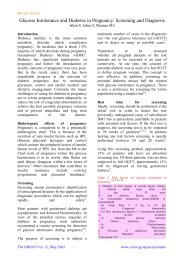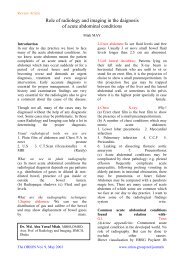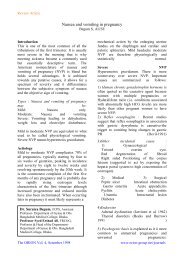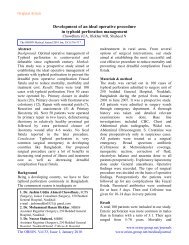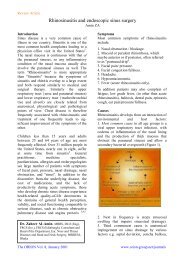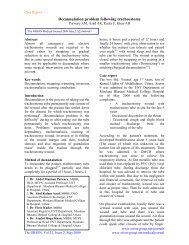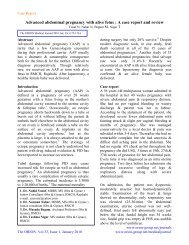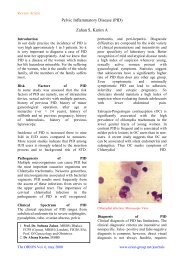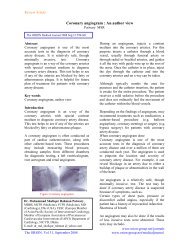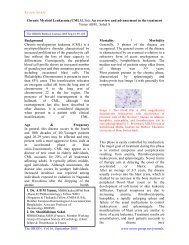A retrospective study - Orion Group
A retrospective study - Orion Group
A retrospective study - Orion Group
You also want an ePaper? Increase the reach of your titles
YUMPU automatically turns print PDFs into web optimized ePapers that Google loves.
Original ArticleBilateral dacryocystectomy in one sitting is convenientthen in two sitting : A <strong>retrospective</strong> <strong>study</strong>Murad MAU, Basory R, Chowdhury FIThe ORION Medical Journal 2007 Jan; 26:438-439AbstractObjective: The <strong>study</strong> compaired the effect ofbilateral dacryocystectomy in one sitting overthe unilateral dacryocystectomy. Method:This <strong>retrospective</strong> <strong>study</strong> was carried out inwhich 27 patients attended at OPD of IslamiaEye Hospital, Dhaka during the period fromJanuary 1997 to October 2000. Those whowere suffering from chronic dacryocystitis ofboth eyes attend hospital for their operationand management. Results: Out of 20 bilateraldacryocystectomy 18 were cured and in 6months follow up no recurrence otherwiseunilateral dacryocystectomy were on 7patients of which 6 did not turn up foroperation of other infected eye. So failure ratewas 85.8%. Ages of the patients werebetween 70 to 80 years. Conclusion: The<strong>study</strong> concludes that bilateraldacryocystectomy was more convenient bothfor the patient and the surgeon.Key wordDacryocystectomy, Bilateral and Unilateral.IntroductionDacryocystitis is an inflammatory conditionof the lacrimal sac (tear sac), which is oftendue to an obstruction of the nasolacrimal duct(tear duct). Chronic infections are morecommon than acute episodes. It is dividedinto 3 types- acute, chronic anddevelopmental. Incidence is 17.9% of totalattendance in eye OPD. "Male & female ratioof dacryocystitis patient was 1:2. Most of the1. Dr. Md. Akhter Uddin Murad, MBBS,DO (Ophthalmology), Associate Professor &Head Dept. of Ophthalmology, InternationalMedical College, Gushlia, Tongi, Gazipur.2.Dr. Rabeya Basory, MBBS, AssistantRegister, Dept. of Ophthalmology, InternationalMedical College, Gushlia, Tongi, Gazipur.3. Dr. Fakrul Islam Chowdhury, MBBS,FCPS (Part- II), CMO, Al Ashraf GeneralHospital, Uttara, Dhaka.The ORION. Vol 26, January 2006Figure: Dacryocystitispatients were poor (54.8%) and illiterate(80.39%) The prevalence was highest 41.2%in age group 41-60 but above 60 age group,characteristically male preponderated" 1 ."Dacryocystitis is highly prevalent inBangladesh. Among the hospitalized eyepatients, the bed occupancy rate bydacryocystitis is next to cataract" 2 . Acutecases can be treated conservatively but inchronic cases it needs surgical interference.Usually dacryocystorhinostomy [DCR] is thechoice of operation. But dacryocystectomy isindicated for old & debilitated patients whereDCR was contraindicated. "With theincreasing age it is common for aqueous tearproduction to decrease" 5 . Treatment ofdacryocystitis is important as because, it is aconstant source of infection. It may causeconjunctivitis, corneal ulcer, cornealperforation, uveitis and endophthalmitis."Untreated dacryocystitis never goesspontaneous resolution" 3 .MethodologyThis was a <strong>retrospective</strong> <strong>study</strong>. During the<strong>study</strong> period 27 patients were selected fromOPD of Islamia Eye Hospital during theperiod of January 1997 to October 2000.Through examination on both ocular andsystemic were done. Following investigationswere routinely done for all patients.1. Vision.www.orion-group.net/journalswww.orion-group.net/medicaljournal
Original Article2. Sac patency test.3. Slit lamp biomicroscopy.4. External examination by wellIlluminated torch.5. Random blood sugar withcorresponding urine.6. ECG.without any complication. Out of 27 patients20 patients were done bilateraldacryocystectomy (74%).In this <strong>study</strong> the patients of cardiovascular,respiratory diseases and extreme old age withother ocular pathology were excluded.OperationUnder local anesthesia a mixture of lidocaine2% and bupivacaine0.5% [3ml+3ml] 6mlwere used in the presence of anesthesiologist.An oblique incision of 4 to 5 mm was givenover the lacrimal sac area 2 to 3 mm awayfrom the medial canthus. Incision was givenby BP blade & wound was enlarged by bluntdissection with artery forceps. Orbicularisoculi muscle was splited by sac dissector.Medial palpebral ligament were incised.Lacrimal sac was visible. Sac were caught byartery forceps and twisted and removed as faras possible by cutting the distal part of thelacrimal sac.Two to three minutes time was taken to seeany abnormal bleeding and stitched of theskin with 6/0 vicryl. 20 patients were giveninterrupted suture and 7 patients were givencosmetic [i.e. Intradermal] by 6/0 silk. Whichwere removing after 7 days? Same procedureswere maintained on the other eyes. Beforestarting the operation diclofenac sodium &lidocaine injection 2 ml were given on thegluteal region [deep I/M]. After completion ofthe operation procedure, the pad and bandagewere given eyes were not covered.Follow up of the patients on 24 hours, 3 days,7 days, 3 weeks and 3 months. After 24 hoursremove the pad and bandage. Slight oedemaaround the operated area was seen but itsubsides automatically with in 7-10 days.ResultsResults in this <strong>study</strong> shows that bilateraldacryocystectomy can be done in one sittingThe ORION. Vol 26, January 2006In this series two patients did not turn up so itwas not known of the fate of those twopatients. In other series of 7 patients who hadunilateral dacryocystectomy (26%) and theycame for follow up for one month and then 6patients out of 7 did not turn up for follow upand other side operation.DiscussionDacryocystitis is a common ocular disease inrural areas. Most of the patients are livingbelow poverty level. They have no extrabudget for health. In rural areas dacryocystitisis called 'Nali' in colloquial languages."Dacryocystitis is more common in femaleespecially at menopausal and postmenopausal age". "At this stage of life there ishypertrophy of mucous membrane of lacrimaldrainage system, which becomes more easilyinfected that usual and can obstructcongenitally narrow bony nasolacrimal canal.This ultimately leads to stasis of tears whereinfection can easily be ensured" 1 ."Source of water for use may have some rolein the aetiology of dacryocystitis, whichneeds to further works" 1 . Poor economicstatus is directly related to the prevalence ofdacryocystitis. However, old established casesof dacryocystitis is not curable by the medicalmeans, surgical interference is ultimatelyneeded.So definite steps should be taken inthis regards. Eye care facilities should beextended to the rural poor people. From theresult of <strong>study</strong> it is evident that those whohave unilateral operation did not turn up (85%)for other side of operation there are manywww.orion-group.net/journalswww.orion-group.net/medicaljournal
Original Articlefactors for this failure. Patients are elderlyusually come form village and they don't haveplace to stay in the city so failure is moreevident. There was <strong>study</strong> where "out of 51only two patient attained eye specialist andboth of them were literate" 1 .ConclusionFrom this <strong>study</strong> the result of this series foundthat bilateral dacryocystectomy can be donewithout complication in one sitting. By thistype of operation time, money, theatre andbed occupancy can be saved. So it isrecommended that a longer series of operationof bilateral dacryocystectomy in one sittingshould be done and if the results are favorablethen it can be adopted for universal procedure.AcknowledgementAuthors are greateful to Prof. M. S. ALAMex-Chief Consultant, Department ofanesthesiology. Bangladesh Medical College,Uttara, Dhaka.Reference1. Islam M. S. Prevalence, distributation anddemographic characteristics of dacryocystitisin rural areas of Kishoreganj district. Originalarticle. BMJ 2000; 29(1-2):3-5.2. Khan M. A. H. et.al. Supporting ceilingstitch of the anterior flap. A device to preventflap, Retreation in DCR Operation. Trans oph.Sec. Bang 1996;23 (2): 6-9.3. Sorsby, A. Modern Ophthalmology. Thelacrimal passages. 2nd edition. 1972;4:997-1012.4. Grover A. K. & Bhatnagar A.Anatomy, Physiology and diseases oflacrimal system in modern ophthalmology. L.C. Datta[ed] 1994;155-171.5. Hart. M. W. Adler's Physiology of the eye,9th edition, 23.The ORION. Vol 26, January 2006www.orion-group.net/journalswww.orion-group.net/medicaljournal



